2014 NISSAN VERSA SEDAN air condition
[x] Cancel search: air conditionPage 336 of 365
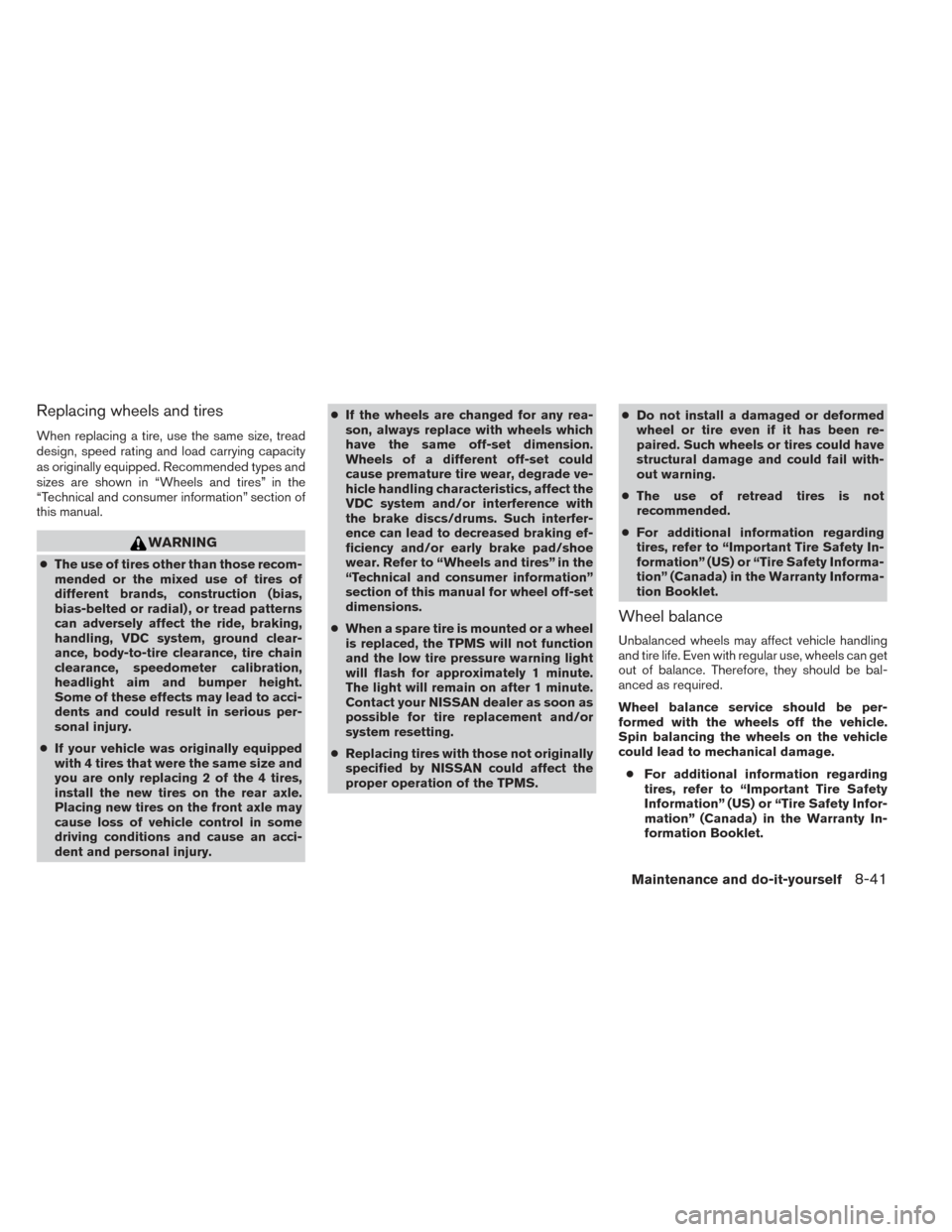
Replacing wheels and tires
When replacing a tire, use the same size, tread
design, speed rating and load carrying capacity
as originally equipped. Recommended types and
sizes are shown in “Wheels and tires” in the
“Technical and consumer information” section of
this manual.
WARNING
●The use of tires other than those recom-
mended or the mixed use of tires of
different brands, construction (bias,
bias-belted or radial) , or tread patterns
can adversely affect the ride, braking,
handling, VDC system, ground clear-
ance, body-to-tire clearance, tire chain
clearance, speedometer calibration,
headlight aim and bumper height.
Some of these effects may lead to acci-
dents and could result in serious per-
sonal injury.
● If your vehicle was originally equipped
with 4 tires that were the same size and
you are only replacing 2 of the 4 tires,
install the new tires on the rear axle.
Placing new tires on the front axle may
cause loss of vehicle control in some
driving conditions and cause an acci-
dent and personal injury. ●
If the wheels are changed for any rea-
son, always replace with wheels which
have the same off-set dimension.
Wheels of a different off-set could
cause premature tire wear, degrade ve-
hicle handling characteristics, affect the
VDC system and/or interference with
the brake discs/drums. Such interfer-
ence can lead to decreased braking ef-
ficiency and/or early brake pad/shoe
wear. Refer to “Wheels and tires” in the
“Technical and consumer information”
section of this manual for wheel off-set
dimensions.
● When a spare tire is mounted or a wheel
is replaced, the TPMS will not function
and the low tire pressure warning light
will flash for approximately 1 minute.
The light will remain on after 1 minute.
Contact your NISSAN dealer as soon as
possible for tire replacement and/or
system resetting.
● Replacing tires with those not originally
specified by NISSAN could affect the
proper operation of the TPMS. ●
Do not install a damaged or deformed
wheel or tire even if it has been re-
paired. Such wheels or tires could have
structural damage and could fail with-
out warning.
● The use of retread tires is not
recommended.
● For additional information regarding
tires, refer to “Important Tire Safety In-
formation” (US) or “Tire Safety Informa-
tion” (Canada) in the Warranty Informa-
tion Booklet.
Wheel balance
Unbalanced wheels may affect vehicle handling
and tire life. Even with regular use, wheels can get
out of balance. Therefore, they should be bal-
anced as required.
Wheel balance service should be per-
formed with the wheels off the vehicle.
Spin balancing the wheels on the vehicle
could lead to mechanical damage.
● For additional information regarding
tires, refer to “Important Tire Safety
Information” (US) or “Tire Safety Infor-
mation” (Canada) in the Warranty In-
formation Booklet.
Maintenance and do-it-yourself8-41
Page 338 of 365
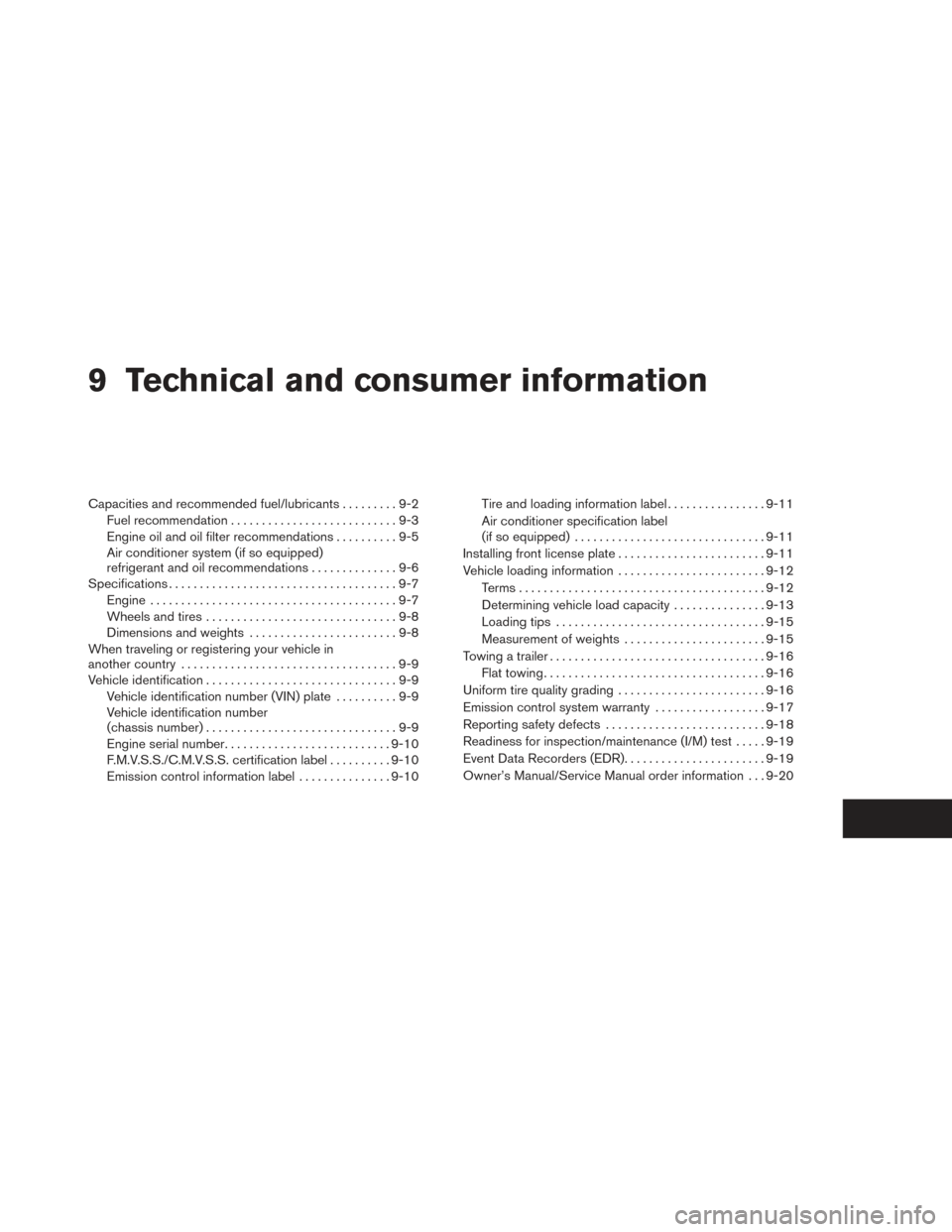
9 Technical and consumer information
Capacities and recommended fuel/lubricants.........9-2
Fuel recommendation ...........................9-3
Engine oil and oil filter recommendations ..........9-5
Air conditioner system (if so equipped)
refrigerant and oil recommendations . .............9-6
Specifications .....................................9-7
Engine ........................................9-7
Wheels and tires ...............................9-8
Dimensions and weights ........................9-8
When traveling or registering your vehicle in
another country ...................................9-9
Vehicle identification ...............................9-9
Vehicle identification number (VIN) plate ..........9-9
Vehicle identification number
(chassis number) ...............................9-9
Engine serial number ........................... 9-10
F.M.V.S.S./C.M.V.S.S. certification label ..........9-10
Emission control information label ...............9-10Tire and loading information label
................9-11
Air conditioner specification label
(if so equipped) ............................... 9-11
Installing front license plate ........................9-11
Vehicle loading information ........................9-12
Terms ........................................ 9-12
Determining vehicle load capacity ...............9-13
Loading tips . . . ............................... 9-15
Measurement of weights .......................9-15
Towing a trailer ................................... 9-16
Flat towing .................................... 9-16
Uniform tire quality grading ........................9-16
Emission control system warranty ..................9-17
Reporting safety defects .......................... 9-18
Readiness for inspection/maintenance (I/M) test .....9-19
Event Data Recorders (EDR) .......................9-19
Owner’s Manual/Service Manual order information . . . 9-20
Page 339 of 365
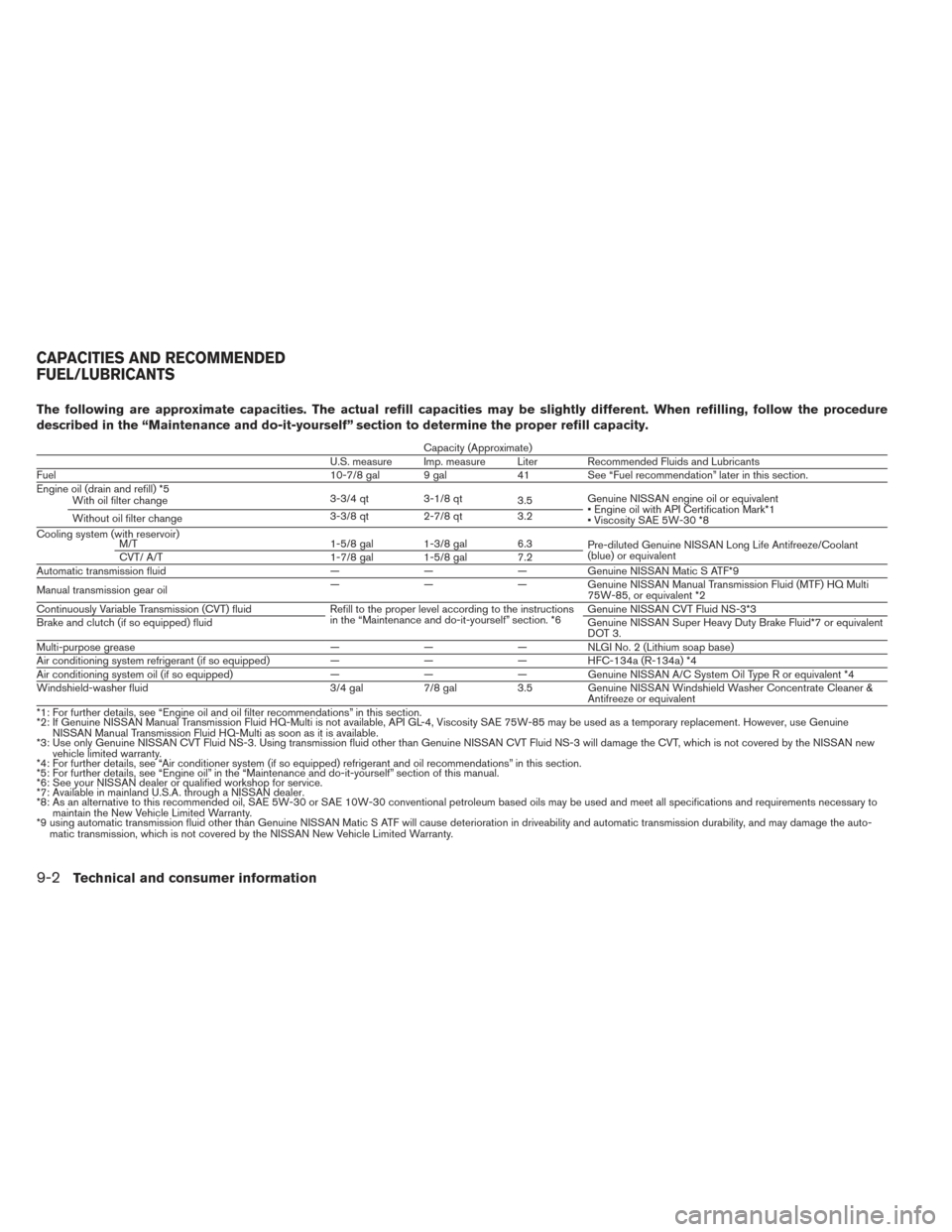
The following are approximate capacities. The actual refill capacities may be slightly different. When refilling, follow the procedure
described in the “Maintenance and do-it-yourself” section to determine the proper refill capacity.
Capacity (Approximate)
U.S. measure Imp. measure Liter Recommended Fluids and Lubricants
Fuel 10-7/8 gal 9 gal 41 See “Fuel recommendation” later in this section.
Engine oil (drain and refill) *5 With oil filter change 3-3/4 qt 3-1/8 qt
3.5Genuine NISSAN engine oil or equivalent
• Engine oil with API Certification Mark*1
• Viscosity SAE 5W-30 *8
Without oil filter change 3-3/8 qt
2-7/8 qt3.2
Cooling system (with reservoir) M/T 1-5/8 gal 1-3/8 gal 6.3
Pre-diluted Genuine NISSAN Long Life Antifreeze/Coolant
(blue) or equivalent
CVT/ A/T 1-7/8 gal 1-5/8 gal 7.2
Automatic transmission fluid ———Genuine NISSAN Matic S ATF*9
Manual transmission gear oil —
——Genuine NISSAN Manual Transmission Fluid (MTF) HQ Multi
75W-85, or equivalent *2
Continuously Variable Transmission (CVT) fluid Refill to the proper level according to the instructions
in the “Maintenance and do-it-yourself” section. *6 Genuine NISSAN CVT Fluid NS-3*3
Brake and clutch (if so equipped) fluid Genuine NISSAN Super Heavy Duty Brake Fluid*7 or equivalent
DOT 3.
Multi-purpose grease ———NLGI No. 2 (Lithium soap base)
Air conditioning system refrigerant (if so equipped) ———HFC-134a (R-134a) *4
Air conditioning system oil (if so equipped) ———Genuine NISSAN A/C System Oil Type R or equivalent *4
Windshield-washer fluid 3/4 gal7/8 gal3.5Genuine NISSAN Windshield Washer Concentrate Cleaner &
Antifreeze or equivalent
*1: For further details, see “Engine oil and oil filter recommendations” in this section.
*2: If Genuine NISSAN Manual Transmission Fluid HQ-Multi is not available, API GL-4, Viscosity SAE 75W-85 may be used as a temporary replacement. However, use Genuine NISSAN Manual Transmission Fluid HQ-Multi as soon as it is available.
*3: Use only Genuine NISSAN CVT Fluid NS-3. Using transmission fluid other than Genuine NISSAN CVT Fluid NS-3 will damage the CVT, which is not covered by the NISSAN new
vehicle limited warranty.
*4: For further details, see “Air conditioner system (if so equipped) refrigerant and oil recommendations” in this section.
*5: For further details, see “Engine oil” in the “Maintenance and do-it-yourself” section of this manual.
*6: See your NISSAN dealer or qualified workshop for service.
*7: Available in mainland U.S.A. through a NISSAN dealer.
*8: As an alternative to this recommended oil, SAE 5W-30 or SAE 10W-30 conventional petroleum based oils may be used and meet all specifications and requirements necessary to
maintain the New Vehicle Limited Warranty.
*9 using automatic transmission fluid other than Genuine NISSAN Matic S ATF will cause deterioration in driveability and automatic transmission durability, and may damage the auto-
matic transmission, which is not covered by the NISSAN New Vehicle Limited Warranty.
CAPACITIES AND RECOMMENDED
FUEL/LUBRICANTS
9-2Technical and consumer information
Page 343 of 365
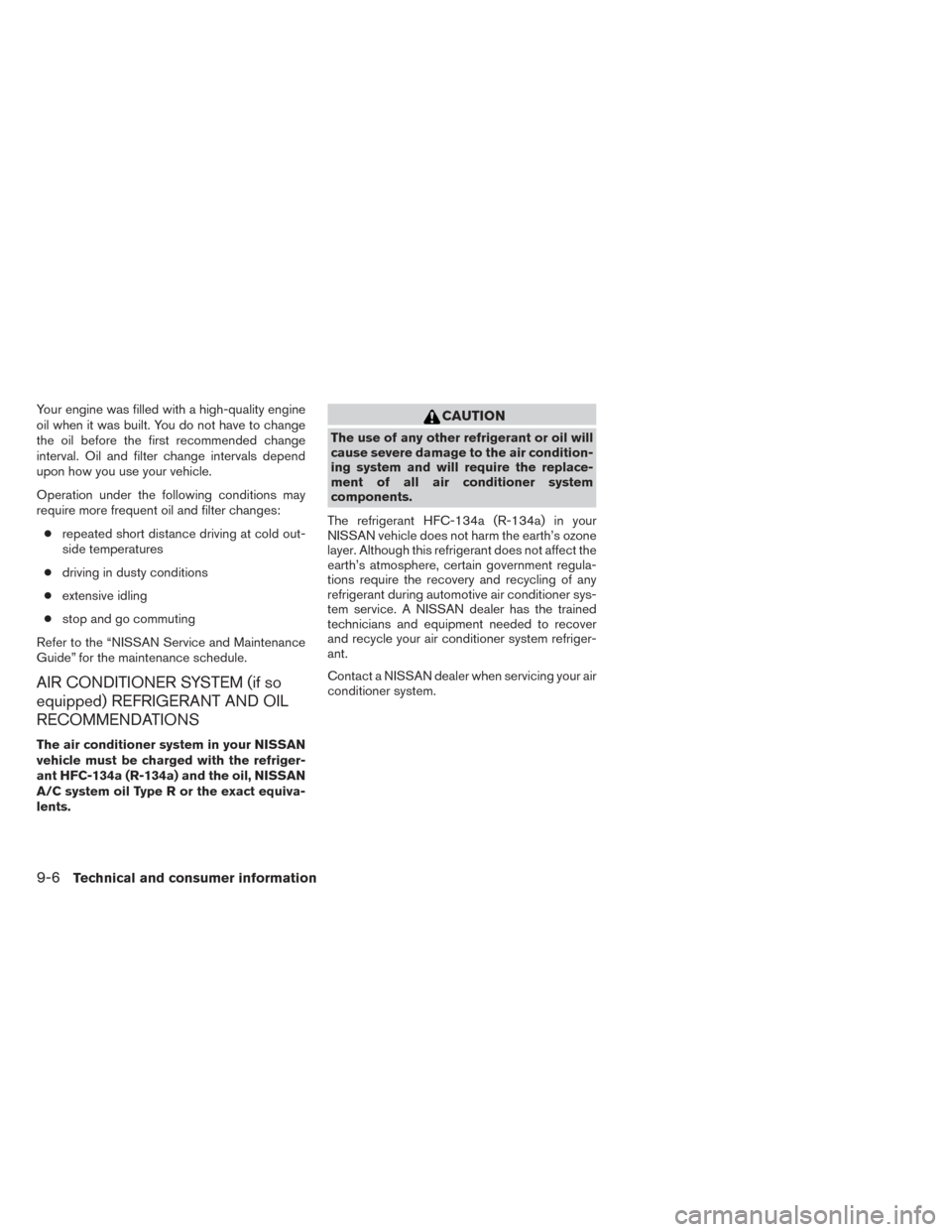
Your engine was filled with a high-quality engine
oil when it was built. You do not have to change
the oil before the first recommended change
interval. Oil and filter change intervals depend
upon how you use your vehicle.
Operation under the following conditions may
require more frequent oil and filter changes:● repeated short distance driving at cold out-
side temperatures
● driving in dusty conditions
● extensive idling
● stop and go commuting
Refer to the “NISSAN Service and Maintenance
Guide” for the maintenance schedule.
AIR CONDITIONER SYSTEM (if so
equipped) REFRIGERANT AND OIL
RECOMMENDATIONS
The air conditioner system in your NISSAN
vehicle must be charged with the refriger-
ant HFC-134a (R-134a) and the oil, NISSAN
A/C system oil Type R or the exact equiva-
lents.
CAUTION
The use of any other refrigerant or oil will
cause severe damage to the air condition-
ing system and will require the replace-
ment of all air conditioner system
components.
The refrigerant HFC-134a (R-134a) in your
NISSAN vehicle does not harm the earth’s ozone
layer. Although this refrigerant does not affect the
earth’s atmosphere, certain government regula-
tions require the recovery and recycling of any
refrigerant during automotive air conditioner sys-
tem service. A NISSAN dealer has the trained
technicians and equipment needed to recover
and recycle your air conditioner system refriger-
ant.
Contact a NISSAN dealer when servicing your air
conditioner system.
9-6Technical and consumer information
Page 348 of 365
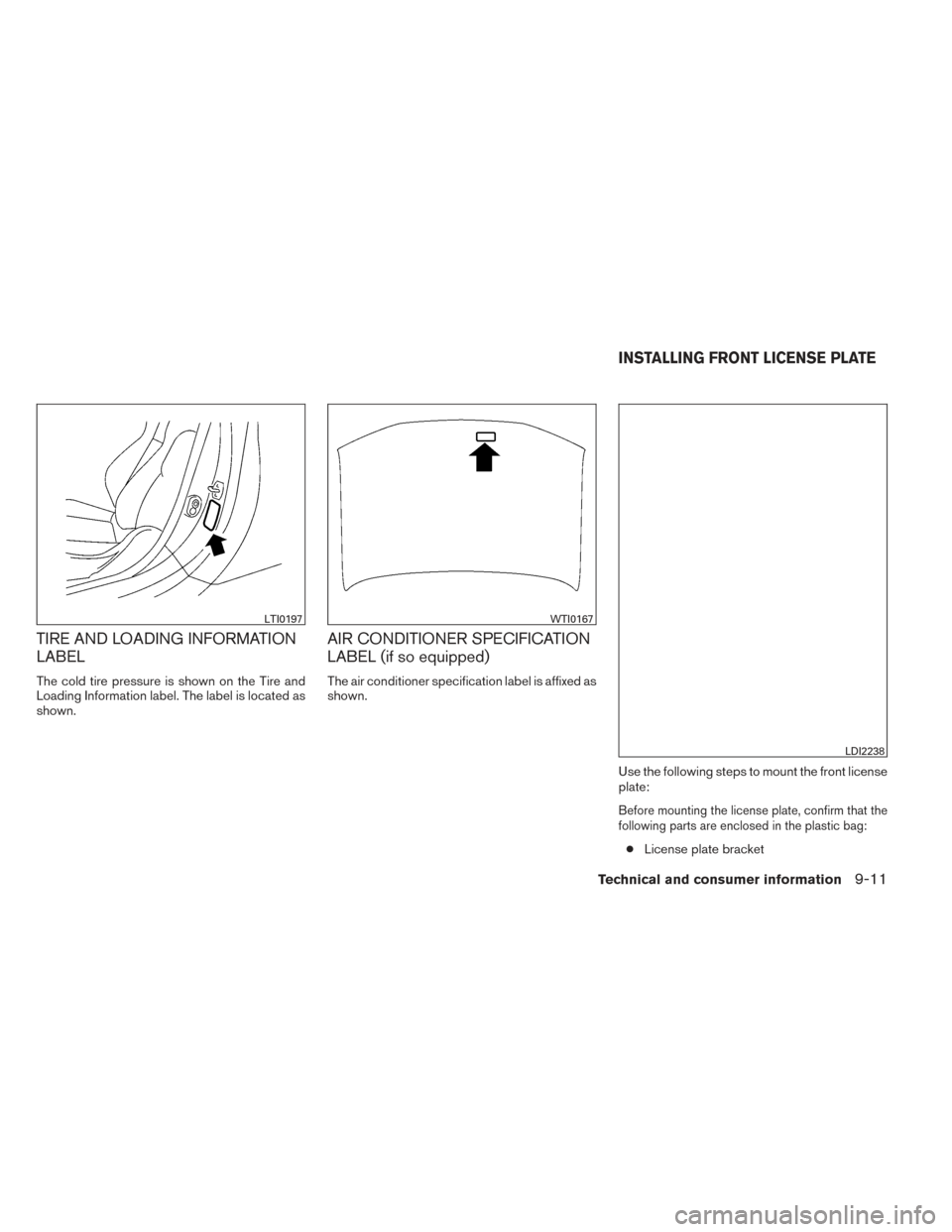
TIRE AND LOADING INFORMATION
LABEL
The cold tire pressure is shown on the Tire and
Loading Information label. The label is located as
shown.
AIR CONDITIONER SPECIFICATION
LABEL (if so equipped)
The air conditioner specification label is affixed as
shown.Use the following steps to mount the front license
plate:
Before mounting the license plate, confirm that the
following parts are enclosed in the plastic bag:
●License plate bracket
LTI0197WTI0167
LDI2238
INSTALLING FRONT LICENSE PLATE
Technical and consumer information9-11
Page 354 of 365
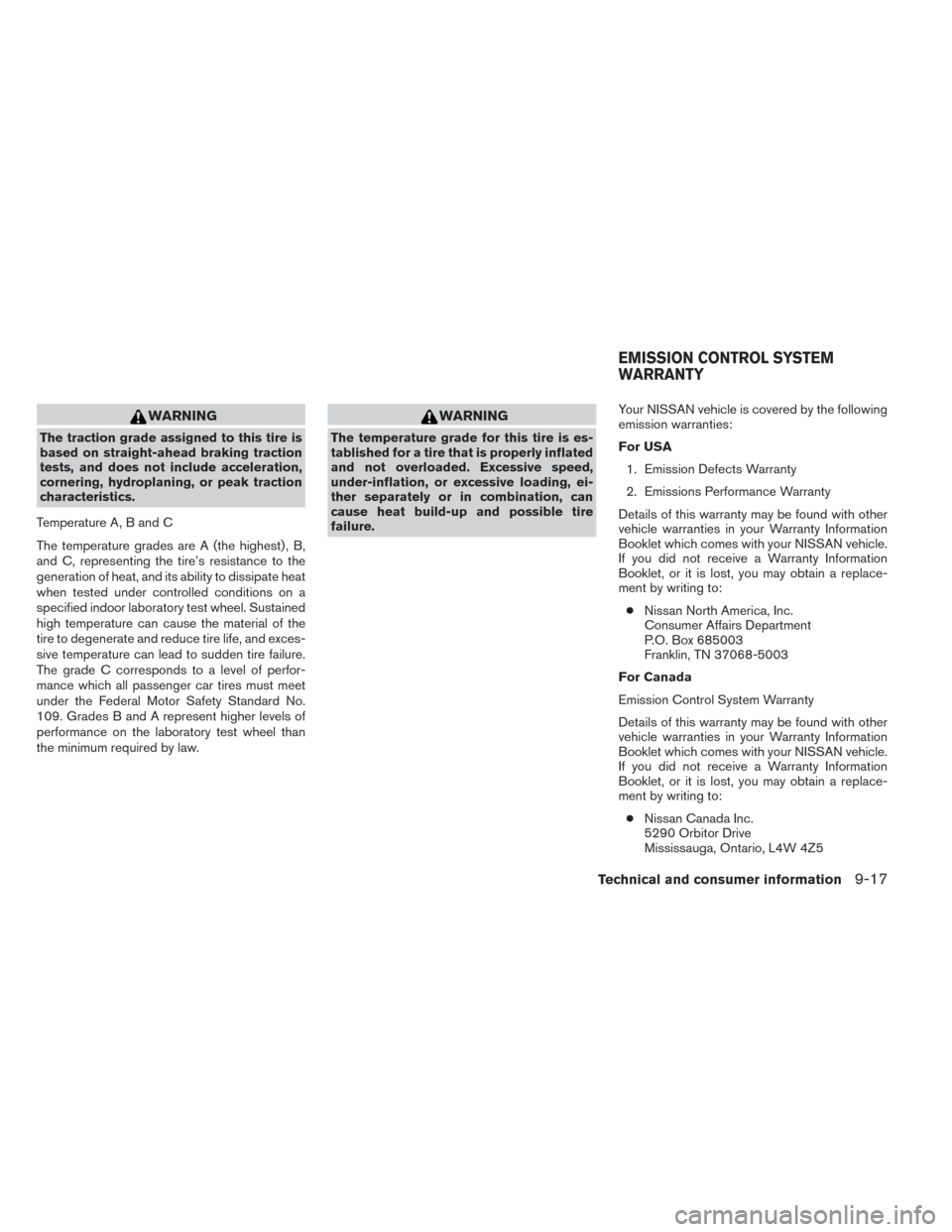
WARNING
The traction grade assigned to this tire is
based on straight-ahead braking traction
tests, and does not include acceleration,
cornering, hydroplaning, or peak traction
characteristics.
Temperature A, B and C
The temperature grades are A (the highest) , B,
and C, representing the tire’s resistance to the
generation of heat, and its ability to dissipate heat
when tested under controlled conditions on a
specified indoor laboratory test wheel. Sustained
high temperature can cause the material of the
tire to degenerate and reduce tire life, and exces-
sive temperature can lead to sudden tire failure.
The grade C corresponds to a level of perfor-
mance which all passenger car tires must meet
under the Federal Motor Safety Standard No.
109. Grades B and A represent higher levels of
performance on the laboratory test wheel than
the minimum required by law.
WARNING
The temperature grade for this tire is es-
tablished for a tire that is properly inflated
and not overloaded. Excessive speed,
under-inflation, or excessive loading, ei-
ther separately or in combination, can
cause heat build-up and possible tire
failure. Your NISSAN vehicle is covered by the following
emission warranties:
For USA
1. Emission Defects Warranty
2. Emissions Performance Warranty
Details of this warranty may be found with other
vehicle warranties in your Warranty Information
Booklet which comes with your NISSAN vehicle.
If you did not receive a Warranty Information
Booklet, or it is lost, you may obtain a replace-
ment by writing to: ● Nissan North America, Inc.
Consumer Affairs Department
P.O. Box 685003
Franklin, TN 37068-5003
For Canada
Emission Control System Warranty
Details of this warranty may be found with other
vehicle warranties in your Warranty Information
Booklet which comes with your NISSAN vehicle.
If you did not receive a Warranty Information
Booklet, or it is lost, you may obtain a replace-
ment by writing to: ● Nissan Canada Inc.
5290 Orbitor Drive
Mississauga, Ontario, L4W 4Z5
EMISSION CONTROL SYSTEM
WARRANTY
Technical and consumer information9-17
Page 356 of 365
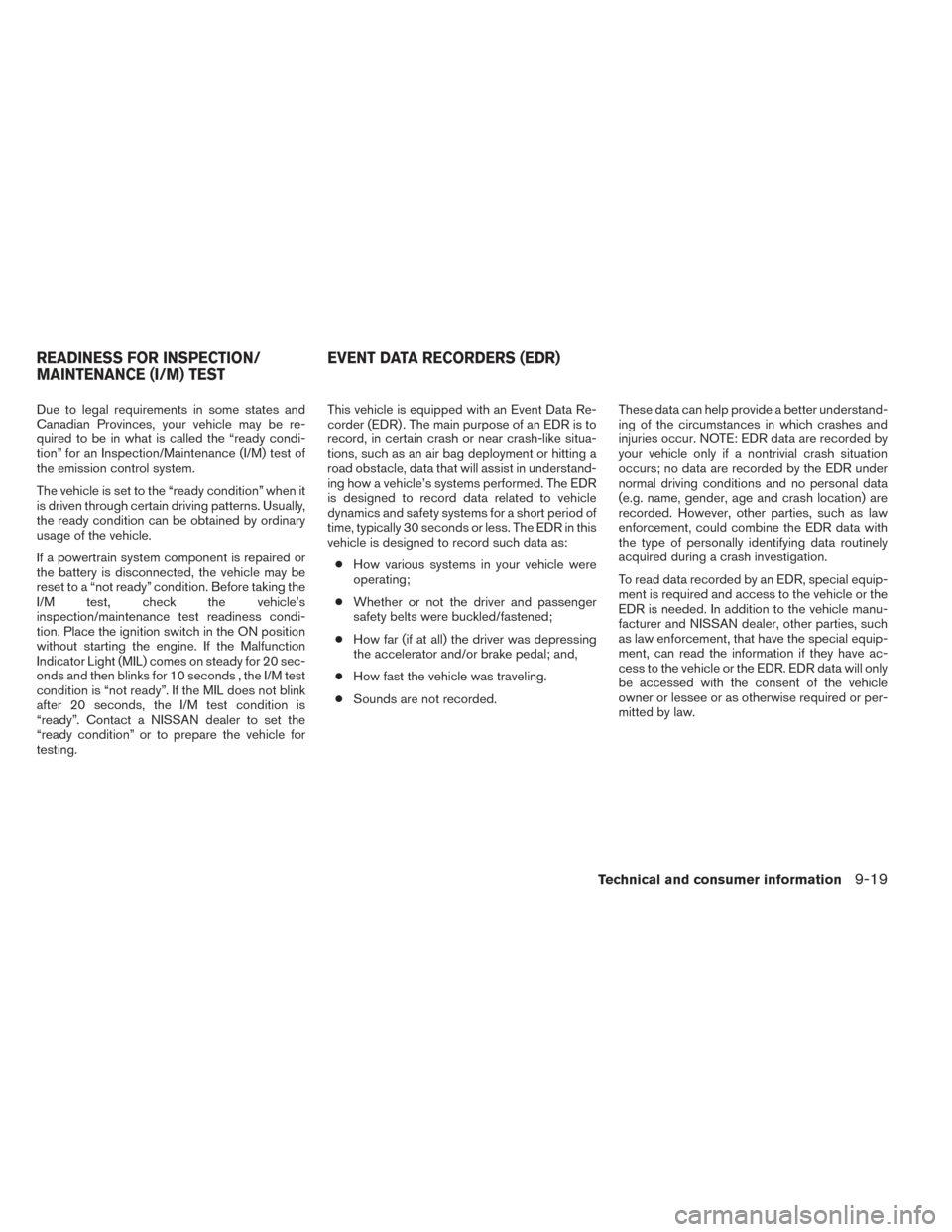
Due to legal requirements in some states and
Canadian Provinces, your vehicle may be re-
quired to be in what is called the “ready condi-
tion” for an Inspection/Maintenance (I/M) test of
the emission control system.
The vehicle is set to the “ready condition” when it
is driven through certain driving patterns. Usually,
the ready condition can be obtained by ordinary
usage of the vehicle.
If a powertrain system component is repaired or
the battery is disconnected, the vehicle may be
reset to a “not ready” condition. Before taking the
I/M test, check the vehicle’s
inspection/maintenance test readiness condi-
tion. Place the ignition switch in the ON position
without starting the engine. If the Malfunction
Indicator Light (MIL) comes on steady for 20 sec-
onds and then blinks for 10 seconds , the I/M test
condition is “not ready”. If the MIL does not blink
after 20 seconds, the I/M test condition is
“ready”. Contact a NISSAN dealer to set the
“ready condition” or to prepare the vehicle for
testing.This vehicle is equipped with an Event Data Re-
corder (EDR) . The main purpose of an EDR is to
record, in certain crash or near crash-like situa-
tions, such as an air bag deployment or hitting a
road obstacle, data that will assist in understand-
ing how a vehicle’s systems performed. The EDR
is designed to record data related to vehicle
dynamics and safety systems for a short period of
time, typically 30 seconds or less. The EDR in this
vehicle is designed to record such data as:
● How various systems in your vehicle were
operating;
● Whether or not the driver and passenger
safety belts were buckled/fastened;
● How far (if at all) the driver was depressing
the accelerator and/or brake pedal; and,
● How fast the vehicle was traveling.
● Sounds are not recorded. These data can help provide a better understand-
ing of the circumstances in which crashes and
injuries occur. NOTE: EDR data are recorded by
your vehicle only if a nontrivial crash situation
occurs; no data are recorded by the EDR under
normal driving conditions and no personal data
(e.g. name, gender, age and crash location) are
recorded. However, other parties, such as law
enforcement, could combine the EDR data with
the type of personally identifying data routinely
acquired during a crash investigation.
To read data recorded by an EDR, special equip-
ment is required and access to the vehicle or the
EDR is needed. In addition to the vehicle manu-
facturer and NISSAN dealer, other parties, such
as law enforcement, that have the special equip-
ment, can read the information if they have ac-
cess to the vehicle or the EDR. EDR data will only
be accessed with the consent of the vehicle
owner or lessee or as otherwise required or per-
mitted by law.
READINESS FOR INSPECTION/
MAINTENANCE (I/M) TEST
EVENT DATA RECORDERS (EDR)
Technical and consumer information9-19
Page 358 of 365
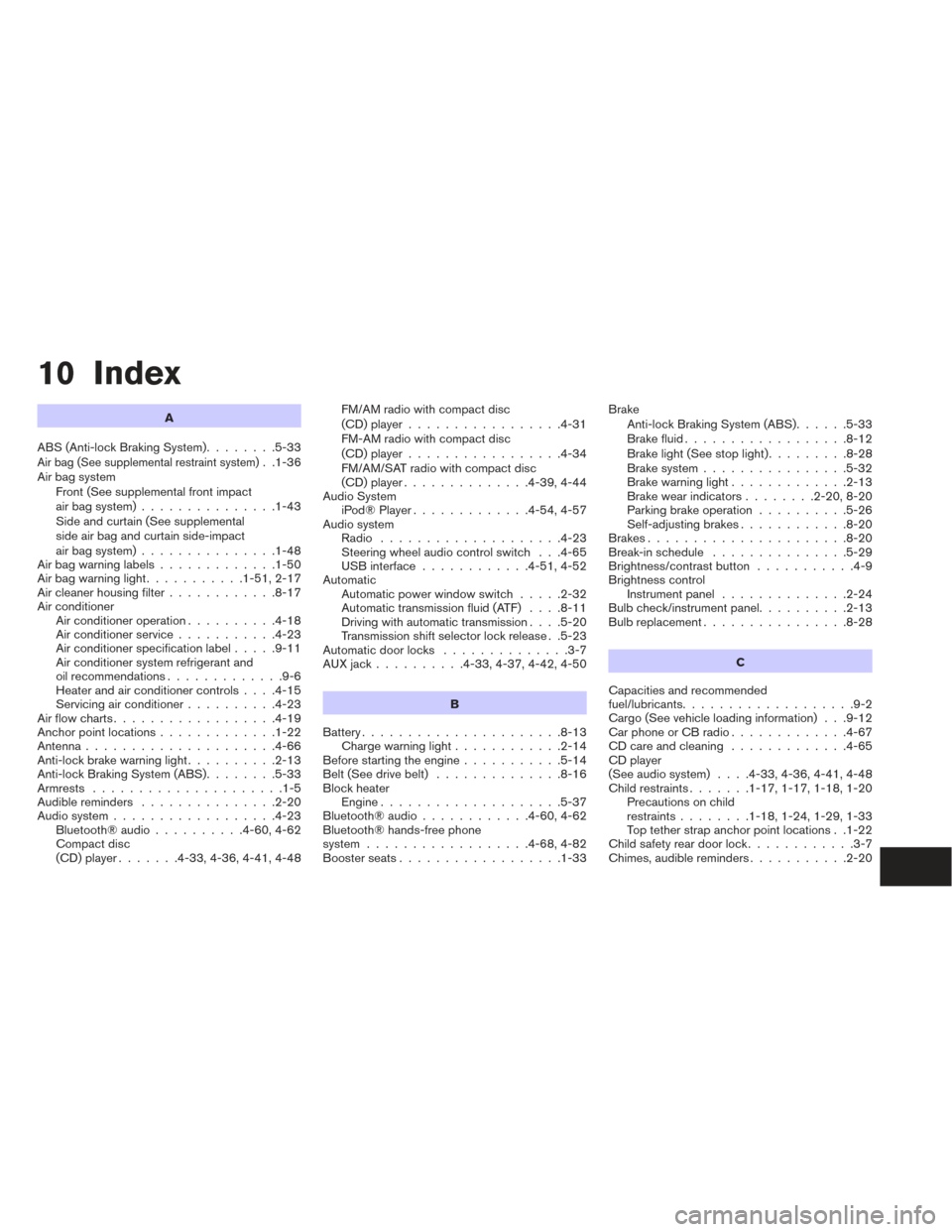
10 Index
A
ABS (Anti-lock Braking System) ........5-33
Air bag (See supplemental restraint system). .1-36
Air bag system Front (See supplemental front impact
air bag system) ...............1-43
Side and curtain (See supplemental
side air bag and curtain side-impact
air bag system) ...............1-48
Airbagwarninglabels.............1-50
Airbagwarninglight...........1-51,2-17
Air cleaner housing filter ............8-17
Air conditioner Air conditioner operation ..........4-18
Air conditioner service ...........4-23
Air conditioner specification label .....9-11
Air conditioner system refrigerant and
oil recommendations .............9-6
Heater and air conditioner controls ....4-15
Servicing air conditioner ..........4-23
Airflowcharts..................4-19
Anchor point locations .............1-22
Antenna.....................4-66
Anti-lock brake warning light ..........2-13
Anti-lock Braking System (ABS) ........5-33
Armrests .....................1-5
Audible reminders ...............2-20
Audio system ..................4-23
Bluetooth®audio..........4-60,4-62
Compact disc
(CD)player.......4-33,4-36,4-41,4-48 FM/AM radio with compact disc
(CD) player
.................4-31
FM-AM radio with compact disc
(CD) player .................4-34
FM/AM/SAT radio with compact disc
(CD) player ..............4-39,4-44
Audio System iPod®Player.............4-54,4-57
Audio system Radio ....................4-23
Steering wheel audio control switch . . .4-65
USB interface ............4-51,4-52
Automatic Automatic power window switch .....2-32
Automatic transmission fluid (ATF) ....8-11
Driving with automatic transmission ....5-20
Transmission shift selector lock release . .5-23
Automatic door locks ..............3-7
AUXjack..........4-33,4-37,4-42,4-50
B
Battery ......................8-13
Charge warning light ............2-14
Before starting the engine ...........5-14
Belt (See drive belt) ..............8-16
Block heater Engine ....................5-37
Bluetooth®audio............4-60,4-62
Bluetooth® hands-free phone
system ..................4-68,4-82
Boosterseats..................1-33 Brake
Anti-lock Braking System (ABS) ......5-33
Brakefluid..................8-12
Brakelight(Seestoplight).........8-28
Brake system ................5-32
Brake warning light .............2-13
Brake wear indicators ........2-20,8-20
Parking brake operation ..........5-26
Self-adjusting brakes ............8-20
Brakes ......................8-20
Break-inschedule ...............5-29
Brightness/contrast button ...........4-9
Brightness control Instrument panel ..............2-24
Bulb check/instrument panel ..........2-13
Bulbreplacement................8-28
C
Capacities and recommended
fuel/lubricants ...................9-2
Cargo (See vehicle loading information) . . .9-12
Car phone or CB radio .............4-67
CD care and cleaning .............4-65
CD
player
(See audio system) ....4-33,4-36,4-41,4-48
Child restraints .......1-17,1-17,1-18,1-20
Precautions on child
restraints ........1-18,1-24,1-29,1-33
Top tether strap anchor point locations . .1-22
Child safety rear door lock ............3-7
Chimes,audiblereminders...........2-20